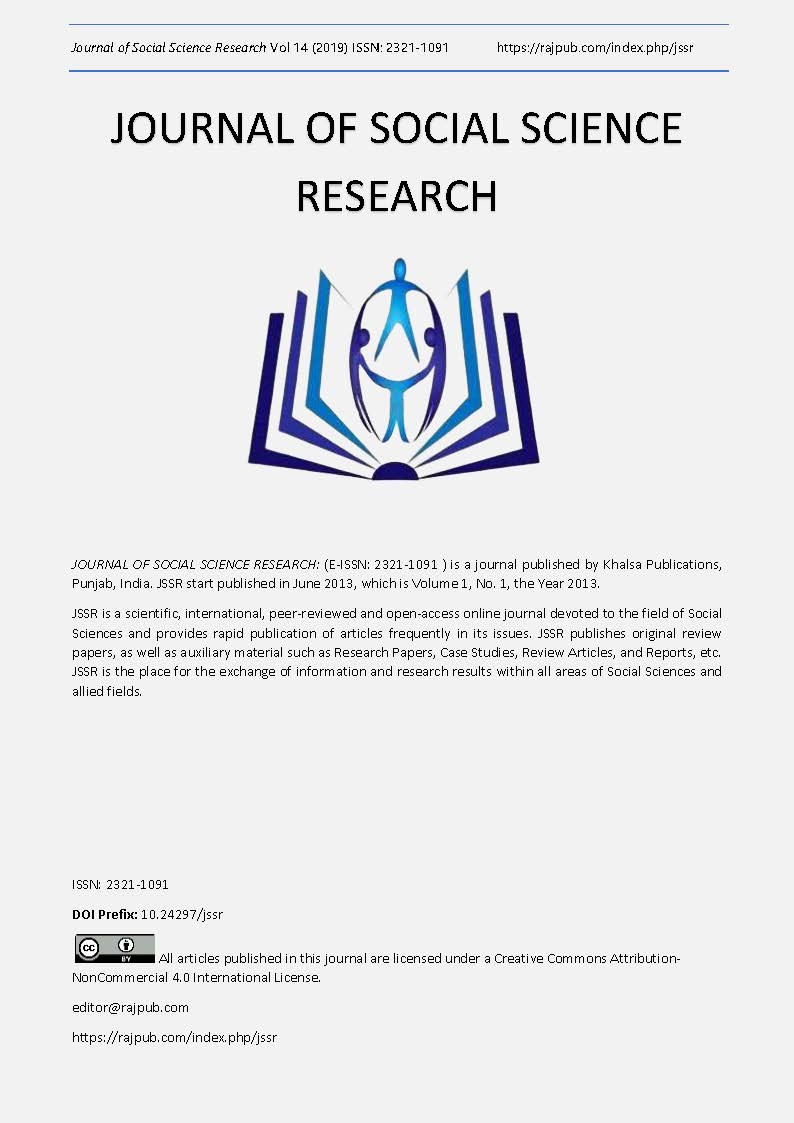Political Dimensions of Weaker Sections Welfare in Local Self Government in India: A Study
DOI:
https://doi.org/10.24297/jssr.v14i0.8111Keywords:
Panchayat Raj Institutions, Political Participation, Weaker SectionsAbstract
Soon after independence, the main thrust of Indian Government centered on meeting the basic needs of India’s population which include food, clothing and shelter. With this perspective, the national policy makers looked at various measures to alleviate the rural poor. The process of self governance and planning by empowering the people through Panchayati Raj system although started nearly five decades earlier, but 73rd and 74th amendments in the Constitution of India brought an historic change in the process of decentralisation towards the grass root level and participation of people both in the formulation as well as implementation of the plans. The paper explores how the Constitution 73rd Amendment Act (1992), provided certainty, continuity and strength to the PRI’s for the welfare of the weaker sections through Decentralization. Uniform three-tier level of the village, block and district levels, direct elections to all seats and at all levels, indirect elections to chairpersons at intermediate and apex levels. Reservation on rotational basis for SC’s ST’s in proportion to their population, both for membership as well as Chairpersonships of the PRI’s. Not less than one third of the seats and offices reserved for women. The present paper intends to discuss the political participation of weaker sections in panchayat raj institutions in Karnataka in general and in Afjalpur taluk of Gulbarga District in particular as a case study. Finally the paper discusses about the political participation of weaker sections and sought their opinion of their involvement in the process of political, economic development and social justice, with the transfer of the list of Eleventh and the Twelfth Schedule of the Constitution to the rural and urban elected local bodies, and the process of welfare activities for weaker sections through the Panchayat Raj Institutions has been discussed.
Downloads
References
Aziz, A. (2000): “Democratic, Decentralization – Experience of Karnataka”.
Bhandare S.A. (2007), “Finance of Hupari Village Panchayat,” M.Phil Dissertation submitted to Shivaji University, Kolhapur.
Bhola Nath Ghosh (2008). ‘Women in Governance in Tripura’ Concept Publishing Company, New Delhi, 2008
Buch, N., Jain, U. and Chaudhary, S.N. (1999): Women in Panchayati Raj in Madhya Pradesh, (Mimeo) Bhopal: Mahila Chetna Manch.
Fernands, Aureliono (2008). ‘Panchayatantra: Empowering Local Government Through Role Definition,’ University Book House, Pvt. Ltd., Jaipur.
Hiremath, Ujwala, May, 1997, Women in Grassroot Politics, Vol. 44, No. 2, Social Welfare, p. 13.
Kadam B. J. (2008), “Village Panchayats and Rural Development: A Case Study of Village Panchayats in Panhala Taluka of Kolhapur District,” M.Phil Dissertation Submitted to Shivaji University, Kolhapur.
Lele, M.K. (2001): “Local Government: Conflict of Interests and Issues of Legitimization”, Economic and Political Weekly, Vol. XXXVI, No. 51, Dec. 22-28.
Maheshwari S.R. (1988). Local Government in India Laskhminarayana Aggrawal, Agra, 1988, p. 61.
Nagendra Ambedkar, New Panchayat Raj at work, ABD Publishers, Jaipur, India, 2000.
Pai, Sudha, May 2, 1998, ‘Pradhanis in New Panchayats’ Field Notes From Meerut District, Economic and Political weekly.
Panchayat Raj at a Glance (as on 31st March, 1964), New Delhi, 1965.
Ram Reddy. G. (1982), “Panchayat Raj and Rural Development in Andhra Pradesh, India” in Norman T. Uphoff, Rural Development and Local Organization in Asia, Macmillan India, Ltd., Delhi, p. 78.
Ramanuja Rao. K and Manduva Narasimha Rao (2005). “Gangadevipally Village: All Round Participation in Village Administration” Kurukshetra, (Jou), Vol.53, No.6, April 2005, PP.31-34.
Sashilata Puri (1978), “Legislative Elite in an Indian State: A Case Study of Rajasthan”, New Delhi: publications, p. 31.
Shivanna N. (1990) “Panchayati raj Reforms and rural Devaelopment”, Usha Prakashan Mandir, Allahabad, p.2.
Singh, S.N. (1996). “Reservation Policy for Backward Classes”, Rawat Publications, Jaipur, New Delhi.
Singh, Surat (2004). Empowerment of Women Representatives in Panchayat Raj- A Profile from Haryana, Kurukshetra, August-2004, Vol.52. No.10, pp.130-139.
Singhi, N.K. (1974) “Bureaucracy, Positions and Participation”, New Delhi: Abhinav Publications, P. 55.
Sinha, Archana (2004). Women in Local Self-Governance, Kurukshetra, April 2001, Vol.52, No.10, 11-15.
Sukla Deb, Kanoongo, January-March, 1996, Panchayat Raj and Emerging Women Leadership, Vol. 46, Social Welfare, p. 86.
Sweeta Mishra. 1994. “Democratic Decentralization in India”, Mittal Publications, New Delhi, 1994, p. 67.
Vinod Vyasulu (2003). Panchayats, Democracy and Development, Rawat Publications, New Delhi.
Downloads
Published
How to Cite
Issue
Section
License
 All articles published in Journal of Advances in Linguistics are licensed under a Creative Commons Attribution 4.0 International License.
All articles published in Journal of Advances in Linguistics are licensed under a Creative Commons Attribution 4.0 International License.




